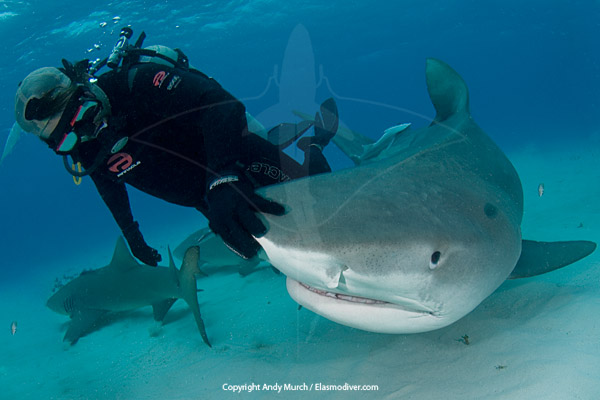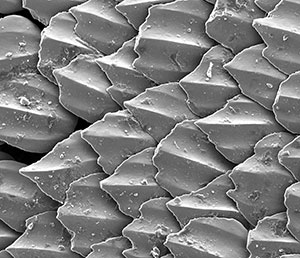 There is still much to be learned from nature. The answers to our survival could possibly be only skin deep. Our test tube antibiotics aren’t working anymore to ward off some deadly infections. Could the key to new treatments lie in the skin of a fearsome deadly creature in the ocean? Will it be a new way to kill deadly infections in humans? There is a 400 year old material that is about to change modern medicine. Shark skin.
There is still much to be learned from nature. The answers to our survival could possibly be only skin deep. Our test tube antibiotics aren’t working anymore to ward off some deadly infections. Could the key to new treatments lie in the skin of a fearsome deadly creature in the ocean? Will it be a new way to kill deadly infections in humans? There is a 400 year old material that is about to change modern medicine. Shark skin. Christina Zinado is a scuba guide in the Bahamas and conducts undersea nature hikes where one can scuba and touch a shark. It is a new and unforgettable feature to the tour. She has established an astounding rapport with the reef sharks. She lures them with fish guts, and by rubbing a female sharks nose, she puts the creature into a trance called chronic immobility; and then you can touch.
Christina Zinado is a scuba guide in the Bahamas and conducts undersea nature hikes where one can scuba and touch a shark. It is a new and unforgettable feature to the tour. She has established an astounding rapport with the reef sharks. She lures them with fish guts, and by rubbing a female sharks nose, she puts the creature into a trance called chronic immobility; and then you can touch.In ten minutes, you can notice that shark skin is spotless. No algae, no barnacles. Nothing grows on a sharks skin. Also, it is smooth as rubber going towards the tail but rough as sandpaper going toward its deadly jaw. Christina says, “The sharks have dermal denticles. It is like special scales that allow the shark to go faster through the water.” Guess who might be interested in that technology?
 At the University of Florida, Bio-Medical Engineer, Tony Brennan, was fascinated that nothing grows on the backs of shark skin. Ships, whales and manatees collect all sorts of bacteria on their skin. Under the electron -microscope he found answers to why sharks do not collect anything . He tried to recreate the patterns found on shark skin to plastic. He noticed that shark denticles are shaped into a diamond pattern. The new plastic is called “Shark let” that has microscopic ridges that mimics the shark skin.
At the University of Florida, Bio-Medical Engineer, Tony Brennan, was fascinated that nothing grows on the backs of shark skin. Ships, whales and manatees collect all sorts of bacteria on their skin. Under the electron -microscope he found answers to why sharks do not collect anything . He tried to recreate the patterns found on shark skin to plastic. He noticed that shark denticles are shaped into a diamond pattern. The new plastic is called “Shark let” that has microscopic ridges that mimics the shark skin. They used the plastic on ships for the Navy, and after sticking the plastic sheets onto ships, nothing grows. The greater interest in shark skin is that bacteria does not grow on it. The health care industry has always done research to kill bacteria. Dr. Schivanty Reddy is the Director of Research for Shark let. She says, “You can kill most bacteria but not all. The one percent that is left is the strongest bacteria and can easily multiply again.”
 Already, there is one type of bacteria called Mrsa that is extremely resistant to almost all antibiotics. It kills more Americans than Aids. What is most interesting that when the same plastic material is made into the diamond pattern vs. smooth sheets, little or no bacteria stayed in the diamond patters whereas plain plastic sheets were covered in dangerous bacteria during experimentation. The new diamond scaled material could be the answer to the problem of secondary infections in hospitals.
Already, there is one type of bacteria called Mrsa that is extremely resistant to almost all antibiotics. It kills more Americans than Aids. What is most interesting that when the same plastic material is made into the diamond pattern vs. smooth sheets, little or no bacteria stayed in the diamond patters whereas plain plastic sheets were covered in dangerous bacteria during experimentation. The new diamond scaled material could be the answer to the problem of secondary infections in hospitals.Plans are being made to wrap bed side tables, wall panels that have to be pulled or touched, the wrist bands that no one ever cleans that are on the patient for the duration of one’s hospital stay. All in an effort to cut down the spread of dangerous bacteria in hospitals. It is only the beginning for the use of this type of patterned plastic sheets.
We think of sharks as the most dangerous predators of the sea but they might be the key to our own survival in the battle of dangerous bacteria that we have gotten resistant to. If Shark let really works, we may really owe sharks our lives. To me , it is the old story of miss-understood beasts. Like the biggest bully in the school-yard, the miss-understood beast may one day be your best friend and bodyguard if you be-friend them and understand them.
No comments:
Post a Comment